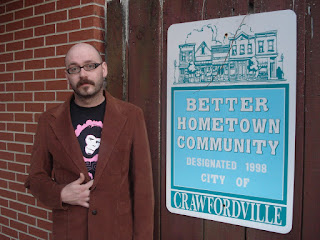For those of us who are truly serious about loving food, those of us who think of bicycle chains and dark alleys when we hear the word "Foodie," Atlanta may be one of the Holy Cities of our faith. It is definitely true that great Southern food can be found in just about any city in the country in which a sizable population of Southerners resides. People tell me you can get good barbeque in Oakland, for instance, and I've found
at least one good soul food place in SF. It is also true that scattered throughout the cities and tiny backwoods towns of the South are more great meals than any one human being could ever imagine to sample in a lifetime (even if said lifetime managed to escape curtailment at the hands of the attendant cholesterol that this cuisine proudly assaults its acolytes with). Each state, each subregion, each city, each cook has their own techniques, tricks, and preferences. And there is of course the omnipresent racial divide. The same dish is sometimes quite different when filtered through the cultural lens of either side of the
melanin line. More talented writers on food have addressed the issues of race in Southern cuisine, and I certainly am not qualified to wrassle that sack of porcupines. Anyway, more germane to the point of this writing is that Atlanta is an embarrassment of riches for the discerning omnivore. The sheer size and historical density of the city, coupled with its citizens' sense of pride in their heritage has resulted in a bewildering array of culinary seductions. I have had the chance to sample a few of them.
The photographs accompanying this post were taken of my meals at
Mary Mac's Tea Room and
Paschal's Restaurant, both of which are Altanta institutions. I also had barbeque at
Daddy D'z this afternoon, and I forgot my camera. These were the three best meals of my visit, and I think that what I have to say here will be mostly taken from those experiences.

Above you see our first course at Mary Mac's: fried crawfish tails and fried okra. The sauces are a vaguely spicy jalapeño cocktail sauce for the mudbugs and a lovely creamed horseradish concoction for the okra. These dishes were good. It's definitely possible to screw up crunchy fried things, but it's hard to make them really outstanding. The okra was fresh. The crawfish tails were probably frozen. Whatever. They were delicious. What is not documented in the photograph is the
amuse bouche of a cup of potlikker and cornbread that we received upon making our order.
That was divine. If you haven't had potlikker before, it's essentially the broth left over from making collard greens. The potlikker at Mary Mac's was subtle, porky, and delicious. Salty enough to make its point without destroying the vibrant flavor of the greens. It was intense enough that I elected not to order the collard as one of the sides with my main course, the fried chicken:

I wish that my camera could convey just how perfect the above meal was. The chicken was simultaneously somehow rich and greasy and dancingly light and crisp. It sat with me for hours afterwards, a gastronomic satori radiating out from my stomach. I have had better fried chicken.
Frenchy's in Houston, for instance, has a far more flavorful batter. But there was something about the combination of comfort-food richness and sure-handed execution that made this bird stand out. I'm sorry I wasn't able to try the lauded buttermilk-marinated yardbird at Scott Peacock's
Watershed in Decateur, but I am pleased with my choice.
The sides I chose for it, the mac and cheese and the hoppin' john were equally stellar. The mac and cheese had a wonderful curd-like consistency, perhaps from the use of ricotta or cottage cheese. The
hoppin' john made me wish that I had forgone the rest of the dinner and just eaten a bowl of these black-eyed peas. I think that more traditionally, hoppin' john is a sort of bean stew, the way that Cajun and Creole cooks make red beans and rice. At Mary Mac's, it was a spoonful of their side order of black-eyed peas over rice. THAT DIDN'T FUCKING MATTER. These little guys were gorgeous. After my first bite, I bewailed my misfortune for having involved rice in the equation, and my dining companion

generously offered to let me finish hers. Predictably enough, she had plenty of that vile carrot and raisin salad left over (I'm sure it was wonderfully executed), and like six beans. Can I tell you? Can I convey the perfect love with which this humble legume was treated? Cooked just enough--firm but tender. Salty, and with an understated hint of pork, floating dreamlike just under the surface of the flavors. This is a wonderful example of how a minimum of ingredients, lovingly handled, can come together in a symphony of flavors that rivals the heights of the most exalted
culinary baroqueries. These beans alone make Mary Mac's worth visiting, and that's saying something, as the rest of the meal was pretty damned sublime.
One jarring note at Mary Mac's was a tiny aspect of the decor. Among the various autographed celebrity photos and newspaper clippings was a little cluster of stories about Georgia's controversial governor,
Lester Maddox, who rode to political success upon the basis of his violent opposition to segregation, famously defending his Pickrick restaurant from black activists, ax-handle and pistol in hand. Apparently, in his later years, Maddox enjoyed celebrating his birthday at Mary Mac's, and a few society-pages clippings chronicle these events. Maddox is a central figure in Georgia's history, and one can argue that his governorship was extremely beneficial to Georgia's African American population. However, he is still a controversial figure, and enshrining him in an establishment where the ownership is white and a large percentage of the employees black is a decision in questionable taste at best.
No such greater socio-political quandaries taint the meal at Paschal's, which is a good thing, because Paschal's needs all the help it can get. It's not bad, mind you, but when compared to Mary Mac's, it comes across as a bit bland. This is a shame, as Paschal's is one of the oldest and most successful black-owned restaurants in Atlanta. In the '50s and 60s, it was a favored meeting place for Dr. King and his aides. The founding Paschal brothers were known to post bail for jailed protesters, and to extend their hours to offer a meeting place for their families to welcome them home. With such a rich and honorable tradition, it is a shame that Paschal's only satisfies, instead of impressing.

This is the Paschal's gumbo. It wasn't by any means bad, just awkward. What seemed like at least two whole bell peppers, cut into quarter-sized pieces floated in the broth, rendering it more of a pepper soup than anything else. Wisps of boiled-to-death chicken floated like faint memories through the startlingly red liquid (over-liberal Tabasco, I'm afraid). Now, I grew up in Louisiana, so maybe I just don't understand the subtleties of Atlantan variations upon Creole cuisine. And like I said, this soup wasn't bad. It just wasn't what I would hope for from a landmark restaurant.

The sides faired much better. Although the mac and cheese lacked the intriguing texture of Mary Mac's, it was very well done, with a perfectly cheddary flavor. I'm afraid that the black-eyed peas were a disappointment after my earlier meal. These were most likely canned, and a bit overcooked. Not at all bad, but not the lethally-focused weapon in use a Mary Mac's. The collards were excellent, though. I suspect that brown sugar is a part of the recipe here, which played up the flavor of the greens rather than the pork, and was very successful.

The chicken-fried steak was just so almost-there as to be heartbreaking. I mean, look at it: the apex of what Brown Food should look like. And yet. And yet. Underseasoned beef, too loose a patty. Batter too quick to wilt under the onslaught of gravy. People, I can't get edible chicken-fried steak in California! What are you doing to me?!
Paschal's seems to have extended its operations very successfully into the catering market, and this can certainly explain why the flagship kitchen belies their reputation. It's tragic, though.
My last meal out in Atlanta was a mess of ribs and a quarter chicken at Daddy D'z on Memorial. This was straight up the best food I've had all week. I can't get good barbeque at home, and this is a constant source of woe, especially since I live a block from the almost-there
Lilly's in SF, and the aroma of smoked meat is a constant in my life. So coming to Atlanta had to culminate with smoked meat. After careful research, I chose Daddy D'z, based on internet reviews, and boy howdy am I glad I did. Something about the way everything was smoked (hickory is the wood of choice, as it is most everywhere but Texas) rendered all the meat into a delightfully liquid consistency that flooded the palate with juicy gorgeousness. The sauce was intense, delightfully deep and vinegary. It's hard to use words to describe successful barbeque, but suffice it to say that this was some of the best I've ever had. Daddy D'z sides were also excellent. The fried okra was as perfectly executed as at Mary Mac's, and the collard greens were hands-down the best of the three presentations I managed to sample this week. As perfectly meaty and salted as Mary Mac's, they had the added distinction of some indefinable earthy, smoky spice that I suspect consisted of a mug of barbeque sauce tossed into the pot with everything else. This was surprising, as usually the sides at a good BBQ place tend to be well-executed afterthoughts at best.
So, that's it for Atlanta food. Those of you who live near me will probably taste the fruits of my fieldwork in the near future. Nothing makes me want to cook so much as eating.

















































